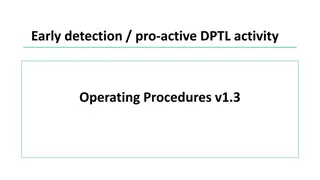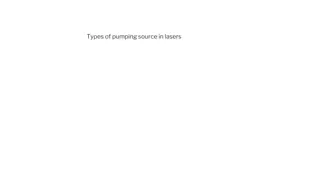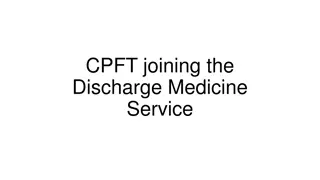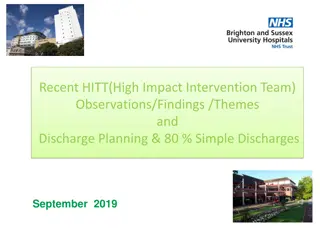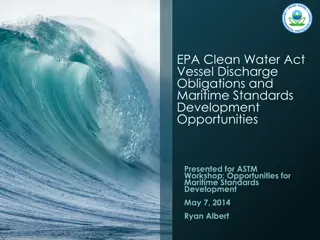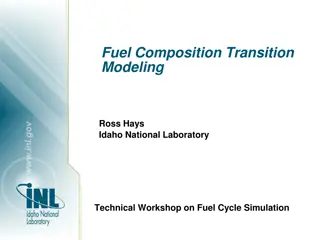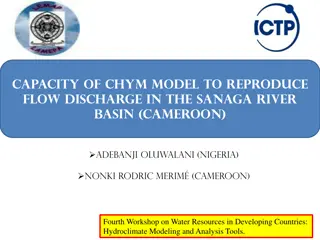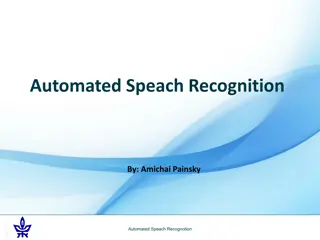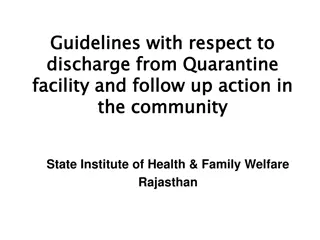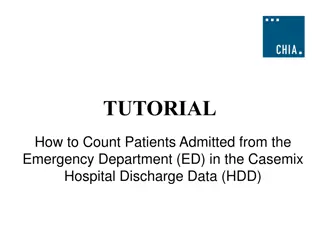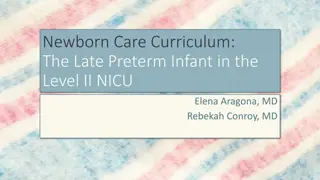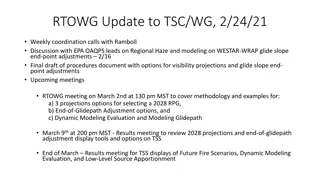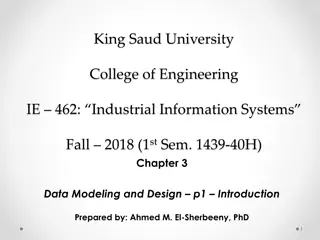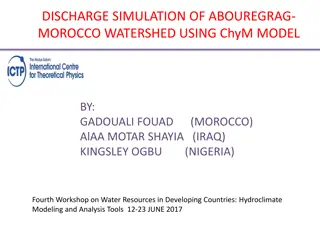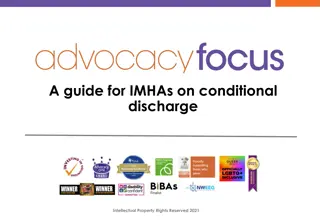NWL Sector Contacts List - Discharge Hub and Local Authority Teams Information
Detailed information on discharge hubs and local authority teams in the NWL sector including contact details for different locations like Brent, Ealing, Hammersmith & Fulham, Hounslow, and Hillingdon. Contacts for managing daily discharge escalations, referral hubs, and leads provided for easy acces
1 views • 23 slides
Implementation of Discharge Card PHB Pilot for Safe and Early Discharge
Addressing the challenge of patients occupying hospital beds unnecessarily, the report focuses on the implementation of the Discharge Card PHB pilot program aiming to facilitate safe and early discharge in hospitals. Real-world barriers and opportunities for optimal e-wallet use in London are explor
3 views • 37 slides
Early Detection and Proactive DPTL Activity Operating Procedures
Coordinated multi-disciplinary team efforts are crucial in preparing patients for discharge promptly to avoid prolonged hospital stays. Early detection and proactive DPTL activity focus on identifying potential discharge obstacles as soon as patients arrive in the emergency department. Various commo
5 views • 13 slides
High Stored Energy Emergency Discharge Systems Overview
This presentation discusses the high stored energy emergency discharge systems for klystron modulators used in RFQ/DTL and MBeta applications. It covers the storage locations of energy in various capacitor banks, the components of the system, and safety measures. The content includes detailed diagra
6 views • 10 slides
Overview of Army Modeling and Simulation Office
The U.S. Army Modeling and Simulation Office (AMSO) serves as the lead activity in developing strategy and policy for the Army Modeling and Simulation Enterprise. It focuses on effective governance, resource management, coordination across various community areas, and training the Army Analysis, Mod
1 views • 8 slides
Types of Pumping Sources in Lasers
Depending on the type of laser, various pumping methods are used including optical pumping, electric discharge pumping, chemical pumping, and heat pumping. Optical pumping utilizes light energy to achieve population inversion in the laser medium, while electric discharge pumping involves passing hig
0 views • 9 slides
Capacity Zone Modeling for Forward Capacity Auction 17 Results
This presentation unveils the Capacity Zone modeling calculations for Forward Capacity Auction 17 associated with the 2026-2027 Capacity Commitment Period by ISO-NE PUBLIC. It delves into boundary definitions, import-constrained zone modeling, and market rules guiding the assessments and modeling pr
0 views • 16 slides
Distribution Feeder Modeling and Analysis Overview
This document delves into the modeling, optimization, and simulation of power distribution systems, specifically focusing on Distribution Feeder Modeling and Analysis. It covers the components of a typical distribution feeder, series components, Wye-Connected Voltage Regulator modeling, and equation
0 views • 14 slides
Understanding Data Modeling vs Object Modeling
Data modeling involves exploring data-oriented structures, identifying entity types, and assigning attributes similar to class modeling in object-oriented development. Object models should not be solely based on existing data schemas due to impedance mismatches between object and relational paradigm
0 views • 17 slides
Evolution of Modeling Methodologies in Telecommunication Standards
Workshop on joint efforts between IEEE 802 and ITU-T Study Group 15 focused on information modeling, data modeling, and system control in the realm of transport systems and equipment. The mandate covers technology architecture, function management, and modeling methodologies like UML to YANG generat
1 views • 16 slides
Understanding Geometric Modeling in CAD
Geometric modeling in computer-aided design (CAD) is crucially done in three key ways: wireframe modeling, surface modeling, and solid modeling. Wireframe modeling represents objects by their edges, whereas surface modeling uses surfaces, vertices, and edges to construct components like a box. Each
1 views • 37 slides
Improving Discharge Medicine Service at CPFT: A Comprehensive Overview
Explore the CPFT's efforts to enhance their Discharge Medicine Service through targeted referrals, specific medication instructions, risk management strategies, and future plans for embedding DMS into practice seamlessly. Discover how they cater to different patient needs and ensure a smooth transit
0 views • 24 slides
Mathematical Modeling and Error Analysis in Engineering
Mathematical modeling plays a crucial role in solving engineering problems efficiently. Numerical methods are powerful tools essential for problem-solving and learning. This chapter explores the importance of studying numerical methods, the concept of mathematical modeling, and the evaluation proces
0 views • 10 slides
Understanding the Discharge of Contract in Contract Law
Discharge of contract signifies the termination of the contractual relationship between parties. It ceases the binding power of the contract, releasing parties from their obligations. Modes of discharge include by performance, agreement, breach, lapse of time, supervening impossibility, and operatio
0 views • 17 slides
Introduction to Dynamic Structural Equation Modeling for Intensive Longitudinal Data
Dynamic Structural Equation Modeling (DSEM) is a powerful analytical tool used to analyze intensive longitudinal data, combining multilevel modeling, time series modeling, structural equation modeling, and time-varying effects modeling. By modeling correlations and changes over time at both individu
0 views • 22 slides
Hospital Discharge and Assessment Processes Overview
Overview of hospital discharge and assessment processes including Discharge to Assess guidelines, Not Meeting Criteria to Reside (NMC2R) protocols, and Bed Based Discharge procedures. Details on timelines, legislation changes, and challenges in ensuring accurate discharges are discussed.
0 views • 8 slides
Analysis of Recent HITT Observations and Discharge Planning in Various Wards
Recent High Impact Intervention Team (HITT) observations and findings related to discharge planning in different wards reveal encouraging outcomes, with a focus on ward training, roles and responsibilities, alignment of resources, and input from multidisciplinary teams. The analysis highlights theme
5 views • 5 slides
Improving Hospital Discharge Processes in South West London
Sandy Keen, Assistant Head of Transformation and Integration, led changes to hospital discharge processes across multiple boroughs in South West London. The initiative focused on enhancing coordination between organizations, streamlining assessments, and prioritizing patient care, resulting in impro
0 views • 6 slides
System Modeling and Simulation Overview
This content provides insights into CPSC 531: System Modeling and Simulation course, covering topics such as performance evaluation, simulation modeling, and terminology in system modeling. It emphasizes the importance of developing simulation programs, advantages of simulation, and key concepts lik
0 views • 28 slides
Understanding Object Modeling in Software Development
Object modeling is a crucial concept in software development, capturing the static structure of a system by depicting objects, their relationships, attributes, and operations. This modeling method aids in demonstrating systems to stakeholders and promotes a deeper understanding of real-world entitie
1 views • 65 slides
United States Environmental Protection Agency (EPA) Clean Water Act Vessel Discharge Obligations Overview
Brief overview of the Clean Water Act (CWA) requirements for vessel discharge obligations under the National Pollutant Discharge Elimination System (NPDES) permitting program. Includes details on the Vessel General Permit (VGP), permit coverage, discharge types, effluent limits, and implementation s
0 views • 18 slides
Coupled Ocean-Atmosphere Modeling on Icosahedral Grids
Coupled ocean-atmosphere modeling on horizontally icosahedral and vertically hybrid-isentropic/isopycnic grids is a cutting-edge approach to modeling climate variability. The design goals aim to achieve a global domain with no grid mismatch at the ocean-atmosphere interface, with key indicators such
1 views • 21 slides
Fuel Composition Transition Modeling in Two-Stage Recycling Reactors
Modeling the transition of fuel composition in a two-stage recycling reactor scenario poses a unique challenge that previous versions of VISION were unable to address. By tracking fuel mass and isotopics through various stages of the fuel cycle, VISION now enables the modeling of reactors with recip
0 views • 15 slides
Fire and Smoke Modeling Evaluation Effort (FASMEE) Overview
FASMEE is a collaborative project aimed at assessing and advancing fire and smoke modeling systems through critical measurement techniques and observational data. Led by key technical leads, FASMEE focuses on diverse modeling areas such as fire growth, effects, coupled fire-atmosphere behavior, smok
5 views • 30 slides
Subarea and Highway Corridor Studies: Travel Demand Modeling and Refinements
In this lesson, we delve into subarea and corridor studies focusing on travel demand model refinements, highway network coding, corridor congestion relief, and trip assignment theory. Subarea modeling plays a crucial role in forecasting travel within smaller regions with detailed traffic patterns, t
1 views • 45 slides
Essential Steps for Setting up a Modeling Study
Ensure clarity on modeling goals and uncertainties. Select sample areas strategically based on interest and available data. Determine appropriate resolution for modeling. Define variables to model and validate the model effectively. Assess sample data adequacy and predictor variables availability. E
0 views • 9 slides
Water Storage Tanks Hydraulic Modeling and Water Quality Considerations
This presentation by Justine Carroll, P.E., Project Manager, focuses on the hydraulic modeling and water quality considerations related to water storage tanks. It covers topics such as water age evaluation, steady state modeling, extended period simulations, pump controls, demand patterns, EPS verif
0 views • 34 slides
Advancing Computational Modeling for National Security and Climate Missions
Irina Tezaur leads the Quantitative Modeling & Analysis Department, focusing on computational modeling and simulation of complex multi-scale, multi-physics problems. Her work benefits DOE nuclear weapons, national security, and climate missions. By employing innovative techniques like model order re
0 views • 6 slides
Flexible Framework for Stormwater Lids Modeling
A new flexible framework for forward and inverse modeling of stormwater lids is presented. It includes governing equations, hydraulic and contaminant transport, numerical methods, and demonstration cases for various green infrastructure components. The importance of different processes in modeling i
0 views • 20 slides
Capacity of CHYM Model to Reproduce Flow Discharge in the Sanaga River Basin
In this study at the Fourth Workshop on Water Resources in Developing Countries, Adebanji Oluwalani and Nonki Rodric Merim analyze the capacity of the CHYM model to replicate flow discharge in the Sanaga River Basin, Cameroon. The study area, data collection, methodology, results, and conclusions ar
0 views • 12 slides
Advocacy Campaign for Sustainable Wastewater Management in Texas Hill Country
An educational advocacy campaign by nonprofit organizations and citizens is promoting sustainable alternatives to direct discharge in the Texas Hill Country and Edwards Aquifer. The campaign aims to galvanize public support through strategic outreach activities, advocating for eco-friendly wastewate
0 views • 26 slides
Understanding Automated Speech Recognition Technologies
Explore the world of Automated Speech Recognition (ASR), including setup, basics, observations, preprocessing, language modeling, acoustic modeling, and Hidden Markov Models. Learn about the process of converting speech signals into transcriptions, the importance of language modeling in ASR accuracy
0 views • 28 slides
Guidelines for Discharge and Follow-Up Post-Quarantine
Guidelines for discharge from a quarantine facility include sample collection, testing, and decision-making procedures, followed by physical discharge on the 18th day. Travelers are informed in advance for onward journey arrangements, with detailed stay plans for the next 14 days. Recommendations fo
0 views • 14 slides
Counting Patients Admitted from Emergency Department in Hospital Discharge Data
Learn how to accurately count patients admitted from the Emergency Department in the Casemix Hospital Discharge Data (HDD). This tutorial covers the methods of filtering by ED Flag Code and Source of Admission Code to identify inpatient discharges admitted through the ED. Understand the significance
0 views • 5 slides
Newborn Care Curriculum for Late Preterm Infants in Level II NICU
This curriculum module focuses on the care of late preterm infants in Level II NICU settings, covering topics such as respiratory management, feeding difficulties, hypoglycemia, hypothermia, sepsis, hyperbilirubinemia, and discharge planning. It includes learning objectives, nursery care levels, phy
1 views • 42 slides
Update on Modeling and Coordination Discussions
Weekly coordination calls with Ramboll and discussions with EPA OAQPS leads focused on Regional Haze and modeling adjustments. Final draft of procedures document with visibility projections and glide slope adjustments. Upcoming RTOWG meetings covering methodology, projections, and modeling evaluatio
0 views • 5 slides
Importance of Data Modeling in Industrial Information Systems
Introduction to data modeling and design in Industrial Information Systems at King Saud University College of Engineering. The chapter covers the significance of data modeling, capturing data characteristics, structural information, and the role of databases and DBMS. Data modeling fills crucial gap
0 views • 51 slides
Discharge Simulation of AbourEgrag Watershed in Morocco Using ChyM Model
Conducted during the Fourth Workshop on Water Resources in Developing Countries, the study focused on simulating discharge in the AbourEgrag watershed in Morocco using the ChyM model. The project objectives included a one-year discharge simulation and evaluation of the model in a flooding case study
0 views • 15 slides
NetLogo - Programmable Modeling Environment for Simulating Natural and Social Phenomena
NetLogo is a powerful and versatile programmable modeling environment created by Uri Wilensky in 1999. It allows users to simulate natural and social phenomena by giving instructions to multiple agents operating independently, making it ideal for modeling complex systems evolving over time. NetLogo
0 views • 7 slides
Understanding Conditional Discharge in Mental Health: A Comprehensive Guide
Explore the complexities of conditional discharge in mental health, from its definition to planning for discharge and post-discharge care. Learn about conditions, frameworks, and recall procedures associated with this critical process. Delve deeper into the nuanced aspects of managing risks and prot
0 views • 31 slides


